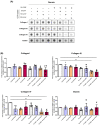The combination of cigarette smoke and solar rays causes effects similar to skin aging in a bilayer skin model
- PMID: 37863977
- PMCID: PMC10589246
- DOI: 10.1038/s41598-023-44868-z
The combination of cigarette smoke and solar rays causes effects similar to skin aging in a bilayer skin model
Abstract
Skin aging is a multifactorial process influenced by internal and external factors. The contribution of different environmental factors has been well established individually in the last few years. On the one hand, man is rarely exposed to a single factor, and on the other hand, there is very little knowledge about how these extrinsic factors may interact with each other or even how the skin may react to chronic exposure. This study aimed to evaluate the effect on skin aging of a chronic co-exposure of tissue-engineered skin substitutes to cigarette smoke extract (CSE) and solar simulator light (SSL). Skin substitutes were reconstructed according to the self-assembly method and then exposed to CSE followed by irradiation with SSL simultaneously transmitting UVA1, visible light and infrared. When skin substitutes were chronically exposed to CSE and SSL, a significant decrease in procollagen I synthesis and the inhibition of Smad2 phosphorylation of the TGF-β signaling pathway were observed. A 6.7-fold increase in MMP-1 activity was also observed when CSE was combined with SSL, resulting in a decrease in collagen III and collagen IV protein expression. The secretory profile resulting from the toxic synergy was investigated and several alterations were observed, notably an increase in the quantities of pro-inflammatory cytokines. The results also revealed the activation of the ERK1/2 (3.4-fold) and JNK (3.3-fold) pathways. Taken together, the results showed that a synergy between the two environmental factors could provoke premature skin aging.
© 2023. Springer Nature Limited.
Conflict of interest statement
The authors declare no competing interests.
Figures







Similar articles
-
Toxic Interaction Between Solar Radiation and Cigarette Smoke on Primary Human Keratinocytes.Photochem Photobiol. 2023 Sep-Oct;99(5):1258-1268. doi: 10.1111/php.13768. Epub 2023 Jan 17. Photochem Photobiol. 2023. PMID: 36537030
-
Regulation of type I procollagen and MMP-1 expression after single or repeated exposure to infrared radiation in human skin.Mech Ageing Dev. 2006 Dec;127(12):875-82. doi: 10.1016/j.mad.2006.09.007. Epub 2006 Oct 25. Mech Ageing Dev. 2006. PMID: 17067654 Clinical Trial.
-
Photocarcinogenesis study of glycolic acid and salicylic acid (CAS Nos. 79-14-1 and 69-72-7) in SKH-1 mice (simulated solar light and topical application study).Natl Toxicol Program Tech Rep Ser. 2007 Sep;(524):1-242. Natl Toxicol Program Tech Rep Ser. 2007. PMID: 21921960
-
Atmospheric skin aging-Contributors and inhibitors.J Cosmet Dermatol. 2018 Apr;17(2):124-137. doi: 10.1111/jocd.12518. J Cosmet Dermatol. 2018. PMID: 29575554 Review.
-
[Environmentally induced (extrinsic) skin aging].Hautarzt. 2016 Feb;67(2):99-102. doi: 10.1007/s00105-015-3750-6. Hautarzt. 2016. PMID: 26769311 Review. German.
Cited by
-
Ebeiedinone and peimisine inhibit cigarette smoke extract-induced oxidative stress injury and apoptosis in BEAS-2B cells.Cell Stress Chaperones. 2024 Dec;29(6):697-708. doi: 10.1016/j.cstres.2024.10.001. Epub 2024 Oct 4. Cell Stress Chaperones. 2024. PMID: 39370036 Free PMC article.
-
Lipid Peroxidation as the Mechanism Underlying Polycyclic Aromatic Hydrocarbons and Sunlight Synergistic Toxicity in Dermal Fibroblasts.Int J Mol Sci. 2024 Feb 5;25(3):1905. doi: 10.3390/ijms25031905. Int J Mol Sci. 2024. PMID: 38339182 Free PMC article.
-
Role of ferroptosis-related IREB2 in the shared genetic etiology between smoking and facial aging: Insights from large-scale genome-wide cross-trait analysis.Comput Struct Biotechnol J. 2025 Jul 30;27:3433-3442. doi: 10.1016/j.csbj.2025.07.049. eCollection 2025. Comput Struct Biotechnol J. 2025. PMID: 40799911 Free PMC article.
-
The effect of smoking and other tobacco product use on perceptions of skin quality and health, approaches to skin care, and minimally invasive cosmetic procedures: A cross-sectional study.Tob Induc Dis. 2025 Aug 22;23. doi: 10.18332/tid/207157. eCollection 2025. Tob Induc Dis. 2025. PMID: 40861880 Free PMC article.
-
Synthetic and Natural Agents Targeting Advanced Glycation End-Products for Skin Anti-Aging: A Comprehensive Review of Experimental and Clinical Studies.Antioxidants (Basel). 2025 Apr 20;14(4):498. doi: 10.3390/antiox14040498. Antioxidants (Basel). 2025. PMID: 40298870 Free PMC article. Review.
References
Publication types
MeSH terms
Substances
LinkOut - more resources
Full Text Sources
Medical
Research Materials
Miscellaneous

